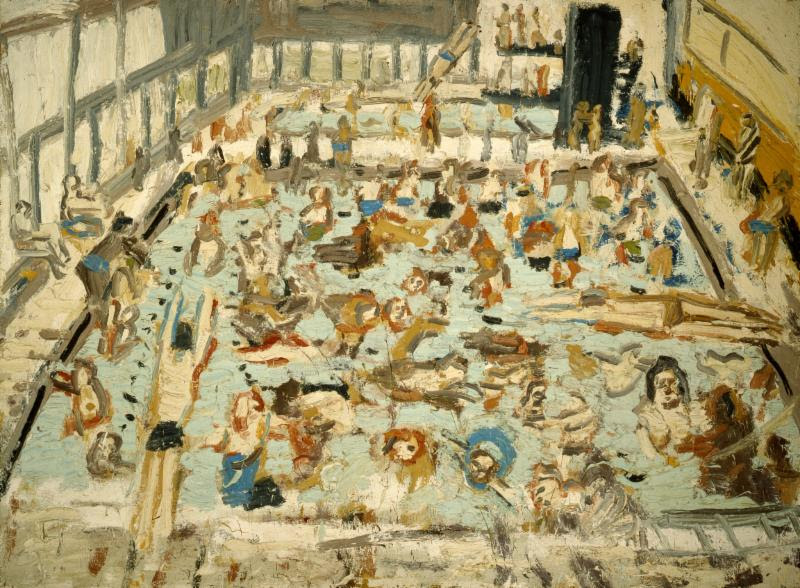[ad_1]

Leon Kossoff, Children’s Swimming Pool, 11 o’clock Saturday Morning, August 1969, 1969, oil on canvas.
©LEON KOSSOFF ESTATE/COURTESY THE LEWIS COLLECTION
Leon Kossoff, whose paintings of his family and London cityscapes have proven to be some of the most essential documents of the mood of postwar Britain, has died at 92. London’s Annely Judea Fine Art gallery, which represents Kossoff, announced the news on Friday morning, and said the artist died on Thursday of a “short illness.”
In its announcement, Annely Judea Fine Art said, “His death robs us of one of Britain’s greatest painters, but his work reminds us of the continuing potency of painting to comprehend the world in which we live.”
Kossoff is widely considered one of the most important British painters to have risen to fame in the years following World War II. Many have placed him in the School of London, an informal and unofficial group of figurative painters that also includes Frank Auerbach, Francis Bacon, and Lucian Freud. (The term “School of London” was contested, both by critics and its own members.) Critic Donald Kuspit has called Kossoff “one of the great painters of his time.”
While Kossoff’s paintings do not depict wartime events, the weight of history hangs over them. When he came to maturity as a painter, during the 1950s, London was still economically depressed and partly destroyed. Having been severely bombed by the Germans during the war, the city was in the process of rebuilding, both on a psychological and a physical level, and Kossoff paintings reflect this through their thick fields of dark hues. (Because of the country’s economic state, lighter paint tones were expensive, and Kossoff and his colleagues could not afford them.) He applied his strokes in such a way that they create frenzied, dour images evocative of loss and anxiety.
[View works from throughout Leon Kossoff’s career.]
Though critics have often viewed his work through this historical context, Kossoff, who did not often give interviews about his work, was typically reticent to say just how much World War II had impacted his art. “Although I have drawn and painted from landscapes and people constantly, I have never finished a picture without first experiencing a huge emptying of all factual and topographical knowledge,” he once wrote, explaining that he hoped to offer “an image which makes itself.”
Even when they depicted lighter material, such as people walking the streets of London or bathers in a public pool, Kossoff’s paintings remain imbued with angst. They tend to render landscapes in such a way that individual forms are downplayed amid an emphasis on harsh, expressionistic strokes. The subjects he chose to depict were not typically beautiful either: railroad tracks in the neighborhoods outside London, construction sites, hulking facades.
Kossoff’s paintings of his family members are likewise unsentimental. A 1963 painting of his mother asleep, for example, depicts her in swirling strokes against a grayish background. Her features can barely be distinguished, and from the angle Kossoff has painted her, she appears dead.
While Kossoff is best known for his paintings, drawing and printmaking were important to his practice. He would often draw his scenes multiple times before completing a painting. “Drawing is a springing to life in the presence of the friend in the studio or in the sunlit summer streets of London,” he once said, adding that “painting is a deepening of this process.”
Kossoff was born in 1926 in the Islington area of London. Raised by Russian Jewish immigrants who had escaped the pogroms in Ukraine, he had six siblings. Essential to his upbringing was a 1935 visit to the National Gallery of Art in the capital city, where he saw Rembrandt van Rijn’s painting Woman Bathing in a Stream (1634). He often said the painting continued to inform his practice as he was maturing as a painter. After the war, during the ’50s, Kossoff took classes with painter David Bomberg in London at the behest of Auerbach that have been considered formative for his practice.
Over the years, Kossoff’s work was exhibited widely in Britain. Tate in London staged a retrospective of his work in 1996, and in 2013 Annely Judea Fine Art held a survey of his work that also ran at Galerie Lelong in Paris, Mitchell-Innes & Nash in New York, and LA Louver in Los Angeles. (The latter two galleries also represented Kossoff.)
Outside the U.K., Kossoff’s paintings were also seen often. He represented the country at the 1995 Venice Biennale, and in 2004 the Louisiana Museum of Modern Art in Humbelbaek, Denmark, surveyed his work. The Metropolitan Museum of Art in New York and the Getty Museum in L.A. have also staged exhibitions of Kossoff’s Nicolas Poussin–inspired work.
Speaking in 2013 of his practice and his vast array of subjects, Kossoff said, “Perhaps everything’s beautiful. It’s a question of how you experience things visually.”
[ad_2]
Source link

